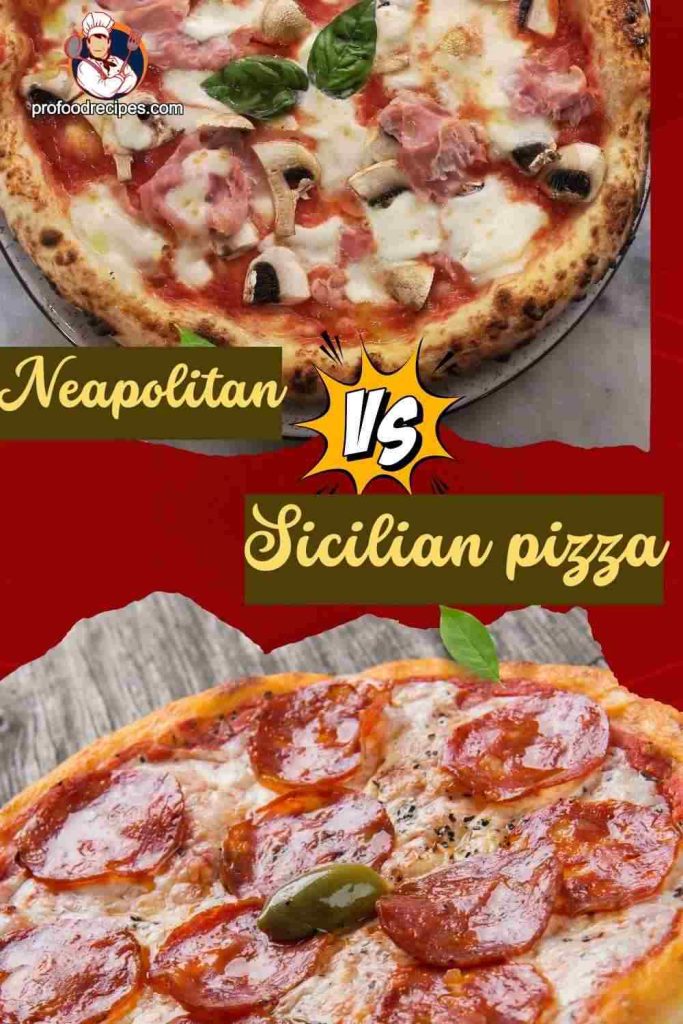Last Updated on November 1, 2023 by Amanda P. Brown
Neapolitan pizza stands out by its thin, chewy crust, simple toppings that highlight the value of each component, rapid baking at high temperatures, and emphasis on authenticity.
However, the Sicilian kind has a thicker, spongey, and rectangular crust, more generous toppings that allow for a wider variety of taste combinations, and lengthier baking in square or rectangular pans, making it more adaptable.
To learn more about the Neapolitan vs Sicilian Pizza and which is better for your taste, read the following article.
Neapolitan Pizza
Table of Contents

Neapolitan pizza is the most famous and oldest pizza of all types of pizzas, which comes from Naples, Italy, in the 18th century. It is a very delicious pizza.
This alluring pizza is very easy to make with fresh and simple ingredients like- fresh mozzarella cheese, olive oil, fresh basil, standard dough, and raw tomatoes. Besides, external toppings are not allowed while preparing Neapolitan pizza. Generally, Neapolitan pizza is pretty small (probably 10-12 inches). Also, this pizza frequently uses more pizza sauce than cheese. Moreover, it is additionally made at extremely high temperatures, like- 800 to 900 Fahrenheit, in a commercial pizza oven or a wood-fired oven for 90 sec.
Variation of Neapolitan Pizzas
Neapolitan pizza has many variations. There are 3-variants of Neapolitan pizzas.
- Pizza Margherita: This pizza has sliced fresh mozzarella, tomato sauce, extra virgin oil or olive oil, fresh basil, and plum tomatoes.
- Pizza Margherita Extra: This pizza, Margherita Extra, has fresh basil, tomato sauce, extra virgin oil, and mozzarella di buffalo (sliced).
- Pizza Marina: Pizza marina includes garlic, tomato sauce, plum tomatoes, oregano, and extra virgin or olive oil.
Sicilian Pizza

Sicilian is the oldest pizza, originating in the capital of Palermo, Sicily. But it is quite different from Neapolitan pizza.
Generally, Sicilian Pizza has a very thick crust. Approximately the crust can be up to 1 inch. This pizza has a spongy, fluffy bread base topped with sauce (meatless), which is made from onions, herbs, tomatoes, and anchovies, and then covered with breadcrumbs and grating of cheese (optional).
In a traditional Sicilian pizza, there is no need to use mozzarella cheese because it produces lots of milk from goats and lambs in Sicily. Also, you will identify sfincione (Sicilian pizza) generally offered in pacifico or bakeshops.
Besides, Sicilian pizza can be baked in a commercial pizza oven in a square tray. Also, you can bake this pizza in an electric oven.
Variation of Sicilian Pizza
There are 2 varieties of Sicilian pizza. They are –
- Unique Sicilian / sfincione
It is the 1st Sicilian pizza which has a soft and rectangular base with mild constancy. This pizza is topped with tomato sauce, anchovies, bread scraps, onions, and herbs. Besides, it is conventional to use caciocavallo (cheddar from lamb’s milk) instead of mozzarella because it is generally retracted from Sicily lamb.
- New York Style Sicilian
It is an American-style Sicilian pizza that has an analogous thickness and shape. In this pizza, it is customary to use mozzarella cheddar instead of caciocavallo (cheddar from lamb’s milk) or toma (cheddar from Italian cow’s milk).
Neapolitan vs Sicilian Pizza- Differences

Between Sicilian and Neapolitan pizza, there are many differences. They differ greatly from one another. I’ll go over a few significant comparison analyses of these pizzas here.
Shape
Generally, a Neapolitan pizza is always round. On the other hand, a Sicilian pizza is mostly rectangular or square.
Size
Size is another essential distinction between these pizzas. Usually, a Neapolitan pizza is 11 – 12 inches, and it is not served in pieces because of its soggy core.
On the contrary, a Sicilian pizza (large size) is 16*16 inches. Besides, it is also offered in 15 slices or 9-slice dimensions.
The Thickness of the Pizza Crust
A key distinction between Sicilian and Neapolitan pizza is the thickness of the crust. There are various types of pizza crust available, like- thick crust, thin crust, custom and focaccia crusts, flatbread crusts, and authentic wood-fired crusts.
Generally, a Neapolitan pizza has a thin crust. Besides, a Sicilian pizza has a thicker crust than a Neapolitan pizza. Also, the crust is more spongy than the Neapolitan pizza.
Oven
A Neapolitan pizza can be baked in a commercial pizza oven or a wood-fired oven. These ovens can reach over 900 degrees Fahrenheit. But in this wood-fired oven, you can’t use wood while preparing the Neapolitan pizza. You will need 2- variants of wood- light wood and thick wood, to provide sufficient heat.
Conversely, a Sicilian pizza is also baked in a commercial oven. But this time, it doesn’t need a wood fire oven because this pizza needs just 425 to 600 degrees Fahrenheit for baking. So, you can easily use your regular home oven to make Sicilian pizza.
Baking Time
To bake a Neapolitan pizza at 900 to 100 degrees Fahrenheit will take about 90 sec.
In contrast, a Sicilian pizza takes about 15 to 20 min at 425 degrees Fahrenheit to bake. But if you are utilizing an outdoor fireplace oven, it will take just 90 sec to prepare.
Ingredients
The primary distinguishing factor between Sicilian and Neapolitan pizza is its ingredients. It is easy to distinguish between the three main ingredients: dough, sauce, and cheese.
Dough
To make Neapolitan pizza dough, you will need top-notch flour (Italian flour 00 or Italian Tipo 00 flour), salt, yeast, and water. Here, flour is the main important element. So, just use only these types of flour which I have mentioned.
On the other side, for Sicilian pizza, the dough is made with flour (regular flour), olive oil, yeast, salt, and water. This soft, spongy, and fluffy dough is made in a square tray and needs extra oil to ensure it’s amazingly crusty.
Sauce
You can use homemade tomato sauce in your Neapolitan pizza. But to make this tomato sauce, you have to use fresh tomatoes. San Marzano tomatoes are another option if you want to enhance their flavor. Additionally, you can use premium pizza sauce.
For the Sicilian pizza, you can also use homemade tomato sauce. But this time, to make tomato sauce, you don’t need to make much effort to find high-quality tomatoes because you can make this sauce by using any kind of tomatoes that are available in every market.
Cheese
Cheese is an essential ingredient for both pizzas. For the Neapolitan pizza, you need to only use mozzarella cheese.
Besides, for the Sicilian pizza, you need to use toma cheese or caciocavallo cheese, which mainly originates from Italy. If you can’t get these cheeses, you can also use mozzarella cheese. There are various types of mozzarella cheese available in every supershop.
The Toppings
In a Neapolitan pizza, tomatoes, olive oil (for Merina), garlic, and oregano are used for topping.
On the other hand, strong cheese, anchovies, herbs, tomatoes, olive oil, and onion are used for Sicilian pizza toppings.
Similarities between Neapolitan and Sicilian Pizza
While Sicilian and Neapolitan pizza differ greatly, they also have many commonalities.
Firstly, both are originated from the same country, Italy. Secondly, both are known as street food. Also, you will find these 2-types of pizza on the pizzeria menus in almost every restaurant. Besides, traditional ingredients are used in both pizzas. Moreover, they are very tasty to eat.
Neapolitan or Sicilian Pizza – Which Taste Better?
Neapolitan pizza is a good option if you’re looking for something traditional and modern, focusing on fresh, local ingredients. On the other hand, Sicilian pizza may be more to your liking if you’re looking for a heartier, thicker crust with a wide variety of toppings and taste combinations. Both are beloved by pizza fans, who often alternate between them. You should give each a try to find out which one you like.
Read More: Homemade Cheese and Tomato Pizza
Final Verdict
Neapolitan or Sicilian Pizza each have their unique characteristics. Each one is special in its way. In addition, they have a lot of fans due to their endearing features.
You May Also Like to Read:
- How Much Cheese on a Pizza?
- How Long Does Pizza Sauce Last in the Fridge?
- How Long Can Pizza Dough Sit Out?
- What Dessert Goes Well After Pizza?
- How to Tell If Pizza Dough Is Bad?
